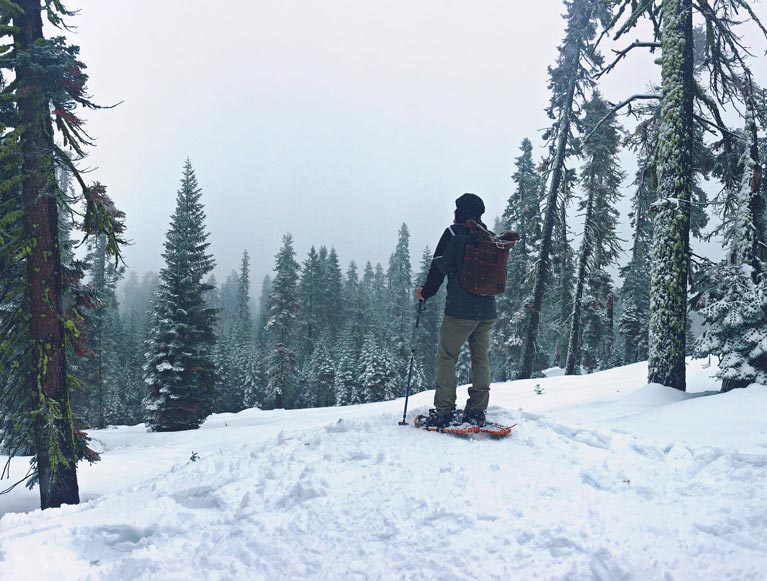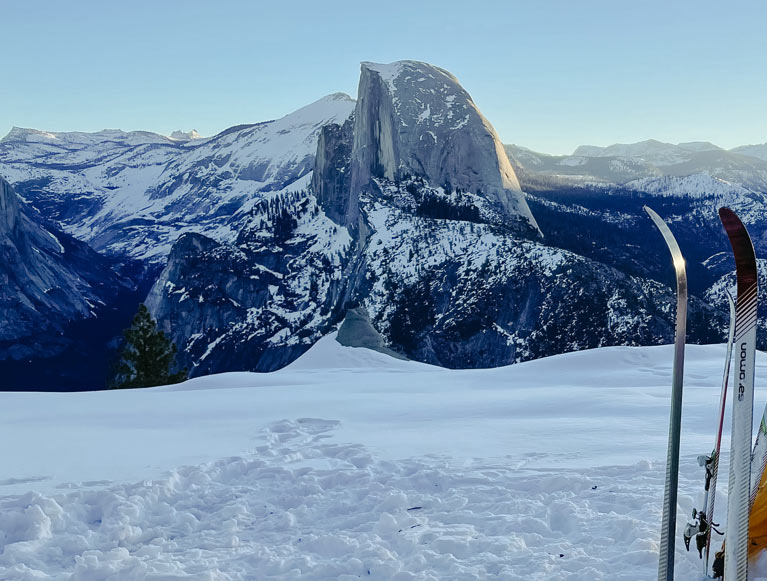

Lower Yosemite Falls
This short and easy trail offers a spectacular view of Yosemite Falls, one of the park’s iconic landmarks. Winter adds a new dimension, with misty spray and icy formations surrounding the falls. A must-see for photographers, this hike is family-friendly and accessible for all skill levels.
- Trail Difficulty: This trail is a paved loop and elevation gain is minimal. Expect icy conditions in the winter.
- Trailhead Information: From the Yosemite Valley Visitor Center, follow the paved bike to the Lower Yosemite Fall shuttle stop and trailhead. Walking clockwise offers the best views!

Snowshoeing to Dewey Point
Dewey Point in Yosemite National Park offers breathtaking views of the snow-covered landscape, including iconic El Capitan and Half Dome in the distance. Just less than 7.5 miles roundtrip, this trail is ideal for a day adventure into Yosemite’s wilderness during the winter.
- Trail Difficulty: Elevation gain is around 760 feet—a moderate and rewarding ascent to sweeping views of Yosemite Valley.
- Trailhead Information: Start from Badger Pass.

Cross-Country Skiing to Glacier Point
For adventurous winter travelers, cross-country skiing to Glacier Point offers an unparalleled experience. This ski trek takes you through pristine snowy forests, across open meadows, and rewards you with some of the most breathtaking views of Yosemite Valley and Half Dome from Glacier Point—only accessible via snowshoeing or cross-country skiing in the winter! This challenging but rewarding journey immerses you in Yosemite’s winter wilderness like no other.
- Trail Difficulty: With an elevation gain of approximately 1,400 feet, the trail is strenuous and best suited to experienced backcountry adventurers.
- Trailhead Information: Start from Badger Pass.
- Permits: Permits are only required if you plan to camp at Glacier Point.

Winter Adventure Tips
- Gear Up: Dress in warm layers, wear waterproof boots, and always use trekking poles, snowshoes, or spikes for added stability on icy or snow-covered trails. For skiing, ensure you have proper cross-country equipment and know your route.
- Check Weather Conditions: Always check current weather and trail conditions before starting your hike or ski trip, as snow and ice can make certain trails more challenging or inaccessible.
- Start Early: To make the most of daylight during short winter days, hit the trail in the early morning.